2019 MERCEDES-BENZ GLB SUV manual transmission
[x] Cancel search: manual transmissionPage 521 of 689
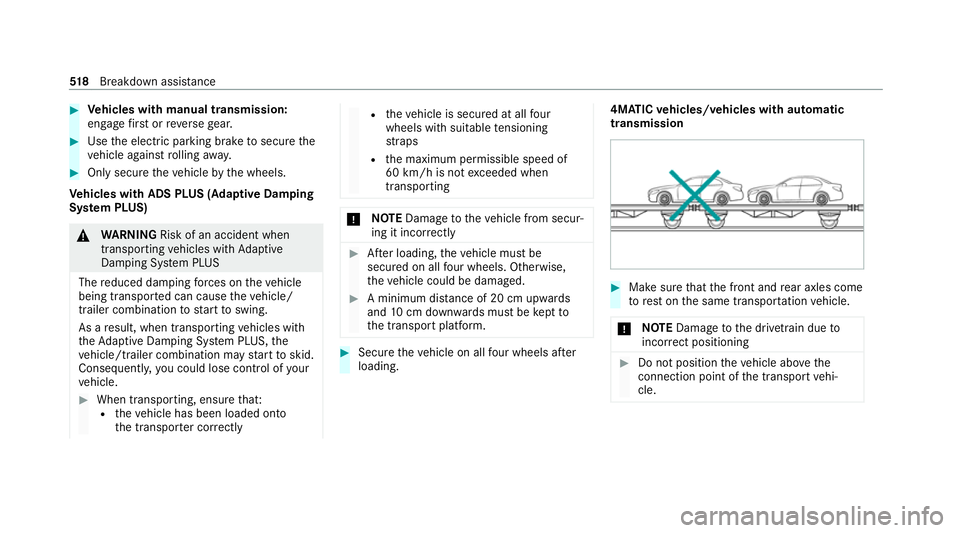
#
Vehicles with manual transmission:
engage firs t or reve rsege ar. #
Use the electric parking brake tosecure the
ve hicle against rolling away. #
Only secure theve hicle bythe wheels.
Ve hicles with ADS PLUS (Adaptive Damping
Sy stem PLUS) &
WARNING Risk of an accident when
transporting vehicles with Adaptive
Damping Sy stem PLUS
The reduced damping forc es on theve hicle
being transpor ted can cause theve hicle/
trailer combination tostart toswing.
As a result, when transporting vehicles with
th eAd aptive Damping Sy stem PLUS, the
ve hicle/trailer combination may start toskid.
Consequentl y,yo u could lose cont rol of your
ve hicle. #
When transporting, ensure that:
R theve hicle has been loaded onto
th e transpor ter cor rectly R
theve hicle is secured at all four
wheels with suitable tensioning
st ra ps
R the maximum permissible speed of
60 km/h is not exceeded when
transporting *
NO
TEDama getotheve hicle from secur‐
ing it incor rectly #
After loading, theve hicle must be
secured on all four wheels. Otherwise,
th eve hicle could be damaged. #
A minimum dis tance of 20 cm up wards
and 10cm down wards must be kept to
th e transport platform. #
Secure theve hicle on all four wheels af ter
loading. 4MATIC
vehicles/ vehicles with automatic
transmission #
Make sure that the front and rear axles come
to rest on the same transpor tation vehicle.
* NO
TEDama getothe driv etra in due to
incor rect positioning #
Do not position theve hicle abo vethe
connection point of the transport vehi‐
cle. 518
Breakdown assis tance
Page 523 of 689

#
Vehicles with automatic transmission
must not be tow- star ted. #
Vehicles with automatic transmission must
not be tow- star ted.
Ve hicles with manual transmission #
Obser vethe no tes on towing away
( / page 516). #
If necessa ry, allow the engine and exhaust
sy stem tocool down. #
Switch the ignition on. #
Enga gesecond gear. #
Release the electric parking brake. #
Tow- start theve hicle while the clutch pedal
is fully depressed. #
Slowly release the clutch pedal. #
Immediately shift toneutral if the engine
st arts. #
Pull over and stop theve hicle, paying atten‐
tion toroad and traf fic conditions. #
Remo vetheto w bar. #
Remo vetheto wing eye. #
Have theve hicle checked at a qualified spe‐
cialist workshop. Electrical fuses
Note
s on electrical fuses &
WARNING Risk of accident and inju ry
due to ov erloaded lines
If yo u manipulate or bridge a faulty fuse or if
yo ure place it with a fuse with a higher
amperage, the electric line could be overloa‐
ded.
This could result in a fire. #
Alw aysre place faulty fuses with speci‐
fi ed new fuses conta iningthe cor rect
amperage. *
NO
TEDama gedue toincor rect fuses Electrical components or sy
stems may be
damaged byincor rect fuses, or their func‐
tionality may be significant lyimpaired. #
Only use fuses that ha vebeen appr oved
by Mercedes-Benz and which ha vethe
cor rect fuse rating. Blown fuses mu
stbe replaced with fuses of the
same rating, which you can recognise bythe col‐
our and fuse rating. The fuse ratings and fu rther
information tobe obser ved can be found in the
fuse assignment diagram.
Fu se assignment diag ram: onthe fuse box in
th e engine compartment (/ page 521).
* NO
TEDama geor malfunctions caused
by moisture Moisture may cause dama
getothe electrical
sy stem or cause it tomalfunction. #
When the fuse box is open, make sure
th at no moisture can enter the fuse
box. #
When closing the fuse box, make sure
th at the seal of the lid is positioned cor‐
re ctly on the fuse box. 520
Breakdown assis tance
Page 542 of 689
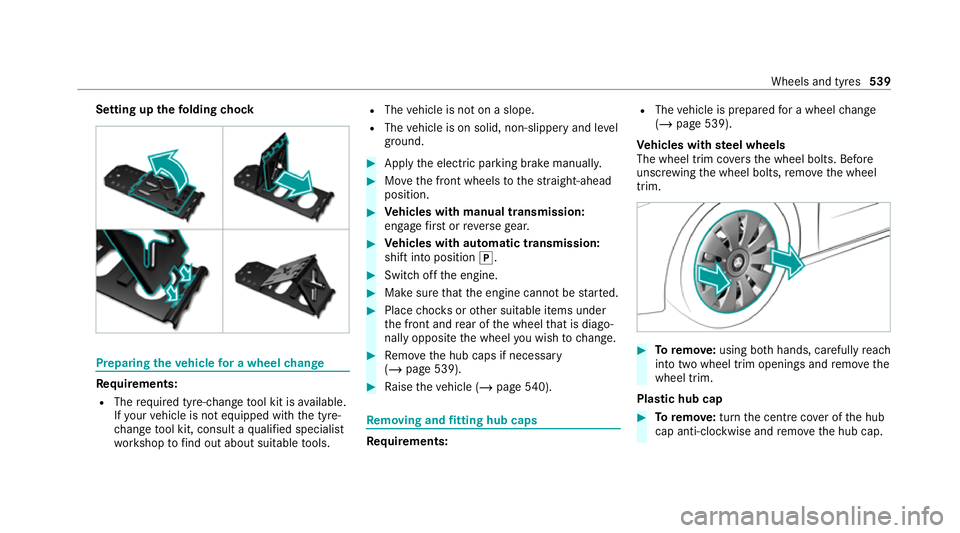
Setting up
thefo lding chock Prepa
ring theve hicle for a wheel change Re
quirements:
R The requ ired tyre-change tool kit is available.
If yo ur vehicle is not equipped with the tyre-
ch ange tool kit, consult a qualified specialist
wo rkshop tofind out about suitable tools. R
The vehicle is not on a slope.
R The vehicle is on solid, non-slippery and le vel
ground. #
Apply the electric parking brake manually. #
Movethe front wheels tothest ra ight-ahead
position. #
Vehicles with manual transmission:
engage firs t or reve rsege ar. #
Vehicles with automatic transmission:
shift into position j. #
Switch off the engine. #
Make sure that the engine cann otbe star ted. #
Place choc ks orother suitable items under
th e front and rear of the wheel that is diago‐
nally opposite the wheel you wish tochange. #
Remo vethe hub caps if necessary
(/ page 539). #
Raise theve hicle (/ page540). Re
moving and fitting hub caps Re
quirements: R
The vehicle is prepared for a wheel change
(/ page 539).
Ve hicles with steel wheels
The wheel trim co vers the wheel bolts. Before
unscr ewing the wheel bolts, remo vethe wheel
trim. #
Toremo ve:using bo thhands, carefully reach
into two wheel trim openings and remo vethe
wheel trim.
Plastic hub cap #
Toremo ve:turn the cent recover of the hub
cap anti-clockwise and remo vethe hub cap. Wheels and tyres
539
Page 582 of 689
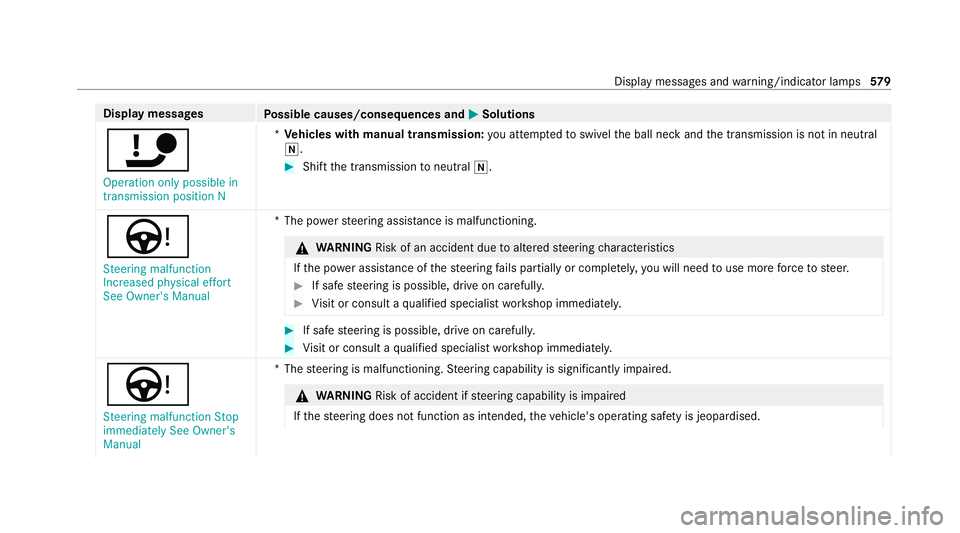
Display messages
Possible causes/consequences and M
MSolutions
ï Operation only possible in
transmission position N *
Ve hicles with manual transmission: you attem ptedto swivel the ball neck and the transmission is not in neutral
i. #
Shift the transmission toneutral i.
Ù Steering malfunction
Increased physical effort
See Owner's Manual *T
he po werst eering assis tance is malfunctioning. &
WARNING Risk of an accident due toaltered steering characteristics
If th e po wer assi stance of thesteering fails partially or comple tely, you will need touse more forc eto steer. #
If safe steering is possible, drive on carefully. #
Visit or consult a qualified specialist workshop immediatel y. #
If safe steering is possible, drive on carefully. #
Visit or consult a qualified specialist workshop immediatel y.
Ù
Steering malfunction Stop
immediately See Owner's
Manual *T
hesteering is malfunctioning. Steering capability is significant lyimpaired. &
WARNING Risk of accident if steering capability is impaired
If th esteering does not function as intended, theve hicle's operating saf ety is jeopardised. Display messages and
warning/indicator lamps 57 9
Page 591 of 689
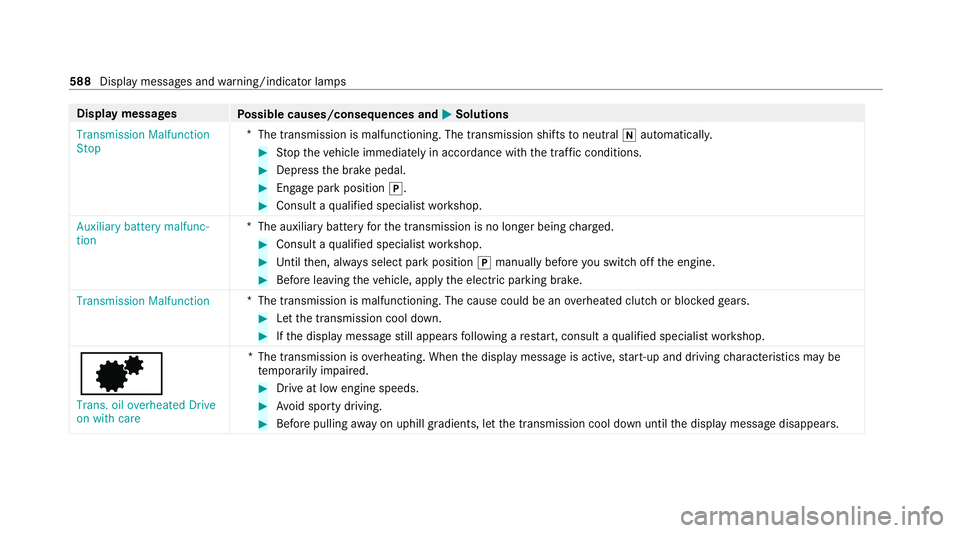
Display messages
Possible causes/consequences and M
MSolutions
Transmission Malfunction
Stop *
The transmission is malfunctioning. The transmission shifts toneutral iautomatically. #
Stop theve hicle immediately in accordance with the traf fic conditions. #
Depress the brake pedal. #
Enga gepark position j. #
Consult a qualified specialist workshop.
Auxiliary battery malfunc-
tion *T
he auxiliary batteryforth e transmission is no longer being charge d. #
Consult a qualified specialist workshop. #
Untilthen, alw ays select park position jmanually before you swit choff the engine. #
Before leaving theve hicle, apply the electric parking brake.
Transmission Malfunction *T
he transmission is malfunctioning. The cause could be an overheated clutch or bloc kedge ars. #
Let the transmission cool down. #
Ifth e display message still appears following a restart, consult a qualified specialist workshop.
d
Trans. oil overheated Drive
on with care *T
he transmission is overheating. When the display message is active, start-up and driving characteristics may be
te mp orarily impaired. #
Drive at low engine speeds. #
Avoid sporty driving. #
Before pulling away on uphill gradients, let the transmission cool down until the display message disappears. 588
Display messages and warning/indicator lamps
Page 592 of 689
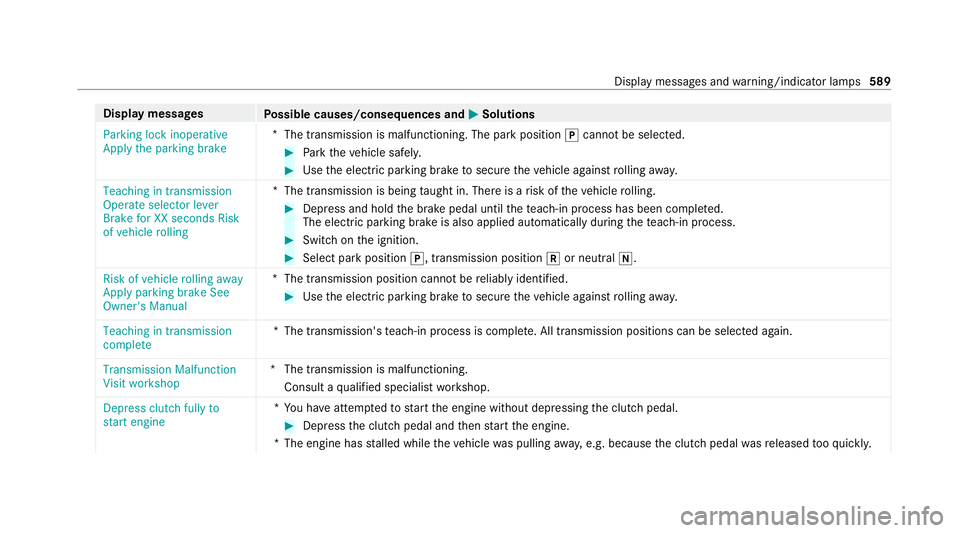
Display messages
Possible causes/consequences and M
MSolutions
Parking lock inoperative
Apply the parking brake *
The transmission is malfunctioning. The park position jcann otbe selected. #
Park theve hicle safely. #
Use the electric parking brake tosecure theve hicle against rolling away.
Teaching in transmission
Operate selector lever
Brake for XX seconds Risk
of vehicle rolling *T
he transmission is being taught in. There is a risk of theve hicle rolling. #
Depress and hold the brake pedal until thete ach-in process has been comple ted.
The elect ric pa rking brake is also applied automatically during thete ach-in process. #
Swit chon the ignition. #
Select park position j, transmission position kor neutral i.
Risk of vehicle rolling away
Apply parking brake See
Owner's Manual *T
he transmission position cannot be reliably identified. #
Use the electric parking brake tosecure theve hicle against rolling away.
Teaching in transmission
complete *T
he transmission's teach-in process is comple te. All transmission positions can be selected again.
Transmission Malfunction
Visit workshop *T
he transmission is malfunctioning.
Consult a qualified specialist workshop.
Depress clutch fully to
start engine *Y
ou ha veattem ptedto start the engine without depressing the clutch pedal. #
Depress the clutch pedal and then start the engine.
*T he engine has stalled while theve hicle was pulling away, e.g. because the clutch pedal wasre leased tooqu ickl y. Displ
aymessa ges and warning/indicator lamps 589
Page 597 of 689
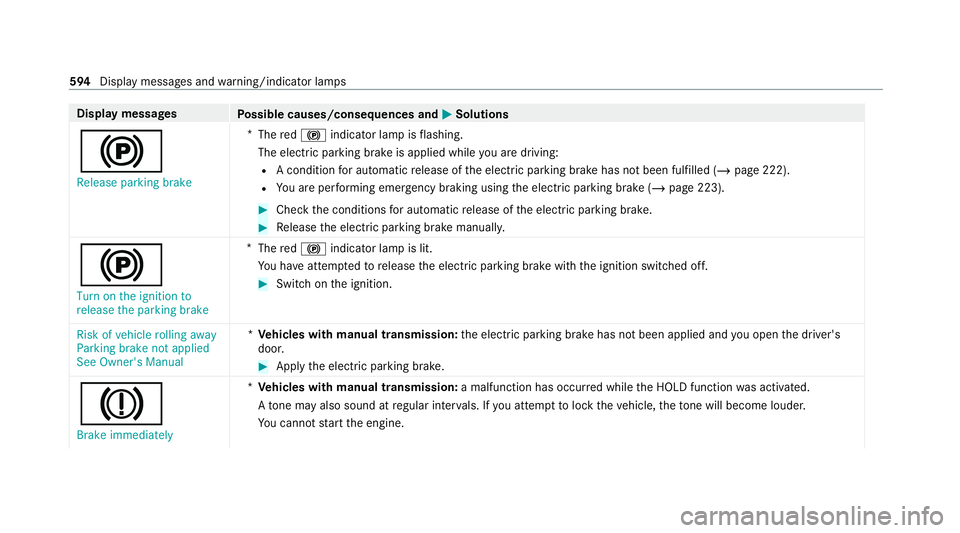
Display messages
Possible causes/consequences and M
MSolutions
! Release parking brake *
The red! indicator lamp is flashing.
The electric parking brake is applied while you are driving:
R A condition for auto matic release of the electric parking brake has not been fulfilled (/ page 222).
R You are per form ing emer gency braking using the electric parking brake (/ page 223). #
Check the conditions for auto matic release of the electric parking brake. #
Release the electric parking brake manually.
!
Turn on the ignition to
release the parking brake *
The red! indicator lamp is lit.
Yo u ha veattem ptedto release the electric parking brake with the ignition switched off. #
Switch on the ignition.
Risk of vehicle rolling away
Parking brake not applied
See Owner's Manual *
Ve hicles with manual transmission: the electric parking brake has not been applied and you open the driver's
door. #
Apply the electric parking brake.
J
Brake immediately *
Ve hicles with manual transmission: a malfunction has occurred while the HOLD function was activated.
A tone may also sound at regular inter vals. If you attem pttolock theve hicle, theto ne will become louder.
Yo u cannot start the engine. 594
Display messages and warning/indicator lamps
Page 646 of 689
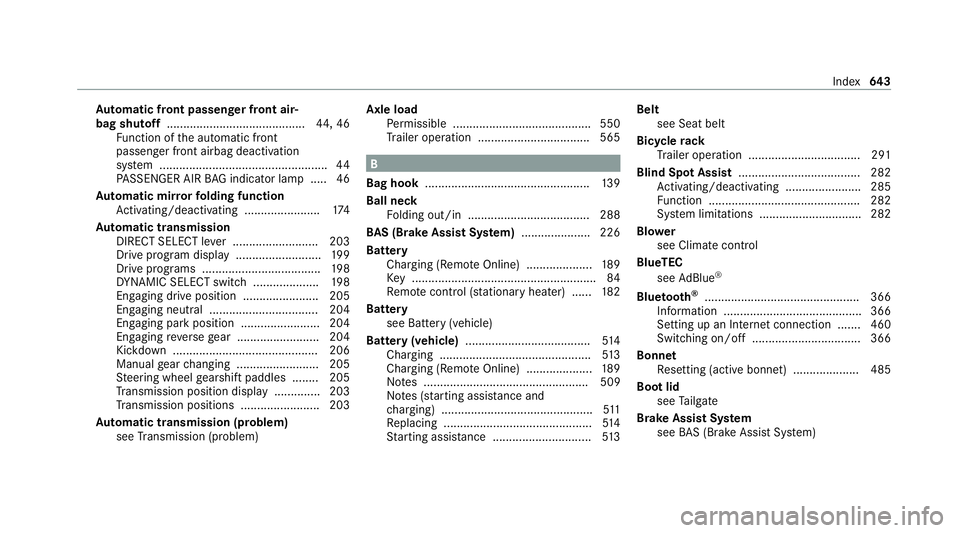
Au
tomatic front passen ger front air‐
bag shu toff .......................................... 44, 46
Fu nction of the automatic front
passenger front airbag deactivation
sy stem ................................................... 44
PA SSENGER AIR BAG indicator lamp .... .46
Au tomatic mir rorfo lding function
Ac tivating/deactivating ...................... .174
Au tomatic transmission
DIRECT SELECT le ver .......................... 203
Drive program display .......................... 19 9
Drive programs .................................... 19 8
DY NA MIC SELECT switch .................... 19 8
Engaging drive position ....................... 205
Engaging neutral ................................. 204
Engaging pa rkposition ........................ 204
Enga gingreve rsege ar ........................ .204
Kickdown ............................................ 206
Manual gear changing ........................ .205
St eering wheel gearshift paddles ........ 205
Tr ansmission position display .............. 203
Tr ansmission positions ........................ 203
Au tomatic transmission (problem)
see Transmission (problem) Axle load
Perm issible .......................................... 550
Tr ailer operation .................................. 565 B
Bag hook .................................................. 13 9
Ball ne ck
Fo lding out/in .................................... .288
BA S (Brake Assist Sy stem) .................... .226
Battery Cha rging (Remo teOnline) .................... 189
Ke y ........................................................ 84
Re mo tecontrol (s tationary heater) ...... 182
Battery see Battery (vehicle)
Battery (vehicle) ...................................... 514
Charging .............................................. 513
Charging (Remo teOnline) .................... 189
No tes .................................................. 509
No tes (s tarting assis tance and
ch arging) .............................................. 511
Re placing .............................................5 14
St arting assis tance .............................. 513Belt
see Seat belt
Bic ycle rack
Tr ailer operation .................................. 291
Blind Spot Assist .................................... .282
Ac tivating/deactivating ...................... .285
Fu nction .............................................. 282
Sy stem limitations ...............................2 82
Blo wer
see Climate control
BlueTEC see AdBlue ®
Blue tooth ®
............................................... 366
Information .......................................... 366
Setting up an Internet connection ....... 460
Switching on/off ................................. 366
Bonnet Resetting (active bonnet) .................... 485
Boot lid see Tailgate
Brake Assist Sy stem
see BAS (Brake Assi stSystem) Index
643